"CONTRADICTIONS"
GLOBAL MARKET SUMMARY
2025 | Q2
US
Commercial real estate showed tentative signs of stabilization, though office space, particularly in central business districts, remains under pressure. National office vacancy reached a record 20.6%, with CBD office values down 51.8% over the past three years. Suburban office fared better, while multifamily housing declined 18.4% over the same period. In the residential market, conditions are gradually normalizing. Home price appreciation slowed to a 13-year low of 1.8% as inventory improved, though affordability remains constrained. Performance has become increasingly regional, with the Midwest and Northeast showing gains while many Sunbelt markets experienced price declines. Rising mortgage rates, property taxes, and insurance costs continue to weigh on demand.
row-spacer
row-spacer
EUROPE
The euro area economy grew 0.6% quarter over quarter and 1.5% year over year, as fixed capital investment and exports offset weak household consumption and flat government spending. Ireland led regional growth, driven by a surge in pharmaceutical exports to the US ahead of threatened tariffs. Broader pull-forward demand supported manufacturing and exports, helping Germany, the bloc’s largest economy, rebound after contracting in late 2024.
Business sentiment remained cautiously optimistic. Firms reported tentative improvements but remained wary amid ongoing trade uncertainty and weak demand. The June HCOB Eurozone Composite PMI held steady at 50.2, signaling marginal expansion. The Manufacturing PMI improved to 49.5, still slightly contractionary, but the highest level since mid-2022, suggesting stabilization in industrial output.
The European Central Bank (ECB) responded to the subdued economic backdrop with two 25 bps rate cuts in Q2. The first, in April, lowered the deposit rate from 2.50% to 2.25%; the second, in June, brought it to 2.00% and marked a shift in tone. ECB President Christine Lagarde signaled a likely pause, stating the bank was “in a good place” and would proceed “meeting by meeting,” guided by data; while inflation had eased toward targets, she cautioned it was too soon to declare victory, citing persistent global risks, especially rising US trade tensions, that could weigh on exports, investment, and inflation expectations.
CHINA
In Q2, US and China trade relations were defined by heightened tensions, sharp tariff escalations, and a late-quarter de-escalation attempt disrupting supply chains and prompting shifts in global sourcing. China’s economy showed mixed signals: domestic consumption remained resilient, with retail sales rising 6.4% year over year in May, while manufacturing weakened; the PMI remained below 50 for a third consecutive month. In response, the People’s Bank of China (PBOC) enacted broad monetary easing, including cuts to key lending rates and reserve requirements, with targeted relief for auto finance and leasing firms. Premier Li Qiang’s dual-circulation strategy continued to emphasize domestic growth as the core driver, supported by trade and investment. Recent policy efforts have been focused on stimulating consumption, upgrading industry, enhancing governance, and encouraging innovation.
JAPAN
Japan’s real GDP contracted slightly in Q1 2025, declining 0.2% on an annualized basis, as elevated input costs and cautious household spending weighed on growth. Private consumption, which makes up more than half of the economy, grew just 0.1%, while net exports detracted 0.8%. The latest Tankan survey by the Bank of Japan (BOJ), the first since the Trump administration’s tariff announcements, showed a modest improvement in the outlook for large manufacturers, although confidence among major auto firms declined sharply due to tariff uncertainty. Confidence among non-manufacturers and services remained elevated, supported by strong inbound tourism and investment in digital transformation. The survey also highlighted a tight labor market and pressure on companies to raise wages. The BOJ’s Board of Governors met twice during the quarter and left rates unchanged at 0.5%, with summaries revealing a divided board balancing inflation risks against a potential global slowdown. Inflation data remained mixed, with overall inflation above the 2% target and core inflation softening. BOJ Governor Ueda signaled a patient, data-dependent stance, while the bank continued tapering its bond purchases by ¥400 billion ($2.76 billion), consistent with its late-2024 roadmap. Meanwhile, Prime Minister Shigeru Ishiba’s administration focused on structural reforms and political consolidation, announcing in May the use of reserve funds to subsidize household and business energy bills, extending measures introduced in April to offset the economic effects of US tariffs.
COMMODITIES
The S&P Goldman Sachs Commodity Index (SPGSCI) declined 2.81% in Q2 2025, marking a notable loss compared to the previous quarter. Livestock (+8.48%) and precious metals (+5.10%) were the top-performing sectors for the second consecutive quarter, while energy (-6.52%) was the largest detractor. Precious metals benefited from safe-haven demand amid ongoing trade tensions and geopolitical uncertainty, whereas conflict-related risks in the Middle East caused a temporary spike in oil prices, but oversupply kept overall levels contained.
Digital assets surged amid institutional interest and regulatory progress. Bitcoin and Ethereum each returned over 30% during the quarter, with most gains realized in April and May. Meanwhile, the US Senate advanced the Genius Act, landmark “stablecoin” legislation that would establish a regulatory framework for issuance and oversight, effectively opening the market to large, regulated financial institutions.
US:
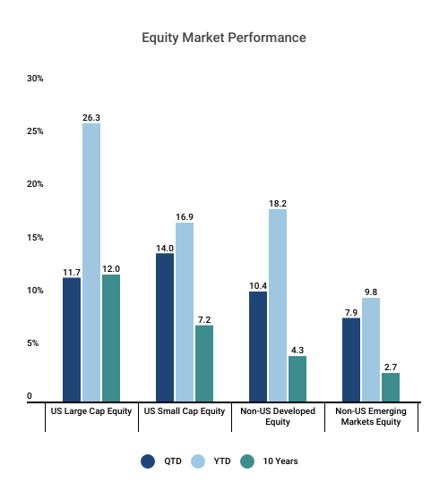
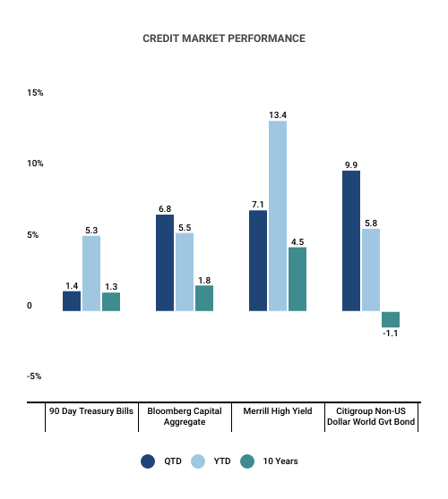
EUROPE:
According to data from Eurostat, economic growth across the Eurozone declined (-0.1% quarter over quarter) in the third quarter, as the region faced headwinds from inflation, rising interest rates, and tightened fiscal policies. Among the larger economies, France, Spain, and Belgium experienced growth while Germany contracted from persistent inflation, high energy prices, and weak foreign demand. Forward-looking economic indicators weakened for the region; the HCOB's final Composite PMI came in at 47.0. Manufacturing activity continued to contract and demand for services declined as consumers pulled back on spending. However, there was some signs of improvement in the manufacturing sub-indices tied to new orders and purchasing activity. Additionally, Eurozone unemployment remained at a record low of 6.4%; employment increased in both services and construction, offsetting weakness in the manufacturing sector. Overall, job vacancy rates have come down from their peaks but remain relatively high by historical standards.
After declining for much of the past year, the rate of inflation across the Eurozone rose to 2.9% in December. The uptick in inflation was primarily due to technical factors, as the impact of base effects and the timing of government subsidies overwhelmed slower price growth for other goods. (Note, core inflation, which doesn’t include energy, food, alcohol, and tobacco prices, ended the year at 3.4%, down from its 2022 peak.) In its last meeting of the year, the European Central Bank (ECB) reaffirmed its benchmark interest-rate policy and announced plans to phase out the last of its COVID-19 era bond-buying programs. The ECB also changed its language around inflation—from describing it as “expected to remain too high for too long,” to saying that it will “decline gradually over the course of next year.” In her statements following the meeting, ECB President Christine Lagarde assumed a more measured tone and argued against calls for imminent cuts to interest rates, stating that it’s too early to “lower our guard” and that the bank is “data dependent, not time dependent.”
CHINA:
China’s economic data in Q4 2023 presented a mixed picture. Industrial output experienced a significant rebound, growing by 4.6% (year on year) in October and an impressive 6.6% in November. This growth—the fastest pace since February 2022—underscored the sector’s recovery and contribution to the economy. On the other hand, already affected by a downturn in the property sector, reduced land sale revenue, and a slowdown in export manufacturing, consumer spending was further impacted by household deleveraging. Credit cards and mortgage loans saw a decline, indicating caution among consumers. Overall spending remained below pre-COVID levels, suggesting a slow and gradual path towards recovery.
In response to the property market's challenges, the Chinese government rolled out several initiatives, including reducing down-payment thresholds and mortgage interest rates, and easing restrictions on second-home purchases. Such measures were designed to ease financial pressure on homebuyers and stimulate market activity. Another notable development was the provision of low-cost financing, amounting to CN¥1 trillion, for urban village renovations and affordable housing projects. This significant investment is intended to support the real-estate sector, a critical component of China's economy. Early indications suggest a positive reception from homebuyers, particularly in major cities, signaling a potential upturn in the real-estate market.
The November 2023 meeting between Chinese President Xi Jinping and US President Joe Biden was a landmark event. Key topics included curbing illicit fentanyl production and military cooperation, alongside a dialogue on artificial intelligence emphasizing the importance of managing risks and safety issues. Described as ‘constructive and productive,’ the meeting underlined both leaders' desire for peaceful coexistence and the necessity of avoiding miscommunication. While it did not resolve all critical geopolitical issues, the meeting was viewed as a positive step towards stabilizing US-China relations. The meeting's conciliatory tone and focus on cooperation in specific areas signaled a potential easing of the strained relations between the two nations.
JAPAN:
Japan’s economy contracted at an annualized growth rate of 2.9% in the third quarter, as a decline in private consumption, which makes up more than half the economy, weighed on economic growth. Although nominal salaries rose year over year, higher prices and inflation wiped out the wage growth in real terms, negatively impacting consumers' purchasing power. In November, Prime Minister Fumio Kishida’s administration announced a new economic stimulus package (approximately $113 billion), aimed at helping households with rising costs. The packages included cuts to income and residential taxes, direct benefits to low earners, extended fuel and electricity subsidies, and funds to support the semiconductor sector.
Japanese business sentiment continued to improve during the quarter as measured by the Tankan survey. Results were especially strong among large manufactures; automakers' moods brightened as the industry benefited from a weak yen and an easing of supply constraints. Non-manufacturing sentiment was positive as well, improving for the seventh straight quarter; recovering inbound tourism gave a significant boost to non-manufacturers. Year to date through November, foreign visitors to Japan topped 20 million for the first time since 2019.
December data showed consumer core inflation trending downwards. Energy and fuel prices declined due to a combination of government subsidies and base effects. However, services inflation persists, driven primarily by demand for accommodations and food. The Bank of Japan (BOJ) ended the year with its low-interest polices in place. In his statement following the BOJ’s December meeting, Governor Kazuo Ueda cooled speculation about future rate hikes, stressing that more data is needed to confirm a positive wage-inflation cycle and the uncertainty surrounding inflation’s sustainability.
COMMODITIES:
The S&P Goldman Sachs Commodity Index (SPGSCI) ended the quarter down with a total return of 10.73%, driven mainly by price gains for industrial metals and precious metals failing to offset weaker prices for energy, agriculture, and livestock. Contrary to Q3 2023, energy (16.74%; S&P GSCI Energy—SPGSEN) underperformed all other SPGSCI sub-index constituents, with sharply lower prices for crude oil, natural gas, and gas oil. These detractors to performance occurred despite output cuts from OPEC+. Agriculture (0.73%; S&P GSCI Agriculture—SPGSAG) ended the quarter with higher prices for soybeans, coffee, wheat, and cocoa failing to offset considerable price declines for sugar, corn, cotton, and Kansas wheat. The precious metals segment outperformed all other commodity constituents during the quarter (10.99%; S&P GSCI Precious Metals—SPGSPM), as both gold and silver achieved robust price gains during Q4 2023. The industrial metals segment realized a modest gain during the quarter (0.82%; S&P GSCI Industrial Metals—SPGSIM), as prices for aluminum, copper, and zinc offset weaker prices for nickel and lead.
Following a relatively quiet period in Q2/Q3 2023, the digital-assets market performed well during Q4. The premier digital token, Bitcoin, was up 57% in Q4 2023, while the second most-popular digital token, Ethereum (ETH), was up 37%, bringing the yearly returns to 155% and 91%, respectively. Speculation over the approval by the Securities and Exchange Commission (SEC) of a US spot Bitcoin exchange-traded fund (ETF) was a significant driver of price movements during the period; this was subsequently approved in January 2024.
![UnderConstruction_shutterstock_415850113 [Converted]](https://www.crewcialpartners.com/hubfs/UnderConstruction_shutterstock_415850113%20%5BConverted%5D.png)
EUROPE
According to data from Eurostat, economic growth across the Eurozone declined (-0.1% quarter over quarter) in the third quarter, as the region faced headwinds from inflation, rising interest rates, and tightened fiscal policies. Among the larger economies, France, Spain, and Belgium experienced growth while Germany contracted from persistent inflation, high energy prices, and weak foreign demand. Forward-looking economic indicators weakened for the region; the HCOB's final Composite PMI came in at 47.0. Manufacturing activity continued to contract and demand for services declined as consumers pulled back on spending. However, there was some signs of improvement in the manufacturing sub-indices tied to new orders and purchasing activity. Additionally, Eurozone unemployment remained at a record low of 6.4%; employment increased in both services and construction, offsetting weakness in the manufacturing sector. Overall, job vacancy rates have come down from their peaks but remain relatively high by historical standards.
After declining for much of the past year, the rate of inflation across the Eurozone rose to 2.9% in December. The uptick in inflation was primarily due to technical factors, as the impact of base effects and the timing of government subsidies overwhelmed slower price growth for other goods. (Note, core inflation, which doesn’t include energy, food, alcohol, and tobacco prices, ended the year at 3.4%, down from its 2022 peak.) In its last meeting of the year, the European Central Bank (ECB) reaffirmed its benchmark interest-rate policy and announced plans to phase out the last of its COVID-19 era bond-buying programs. The ECB also changed its language around inflation—from describing it as “expected to remain too high for too long,” to saying that it will “decline gradually over the course of next year.” In her statements following the meeting, ECB President Christine Lagarde assumed a more measured tone and argued against calls for imminent cuts to interest rates, stating that it’s too early to “lower our guard” and that the bank is “data dependent, not time dependent.”
![UnderConstruction_shutterstock_415850113 [Converted]](https://www.crewcialpartners.com/hubfs/UnderConstruction_shutterstock_415850113%20%5BConverted%5D.png)
CHINA
China’s economic data in Q4 2023 presented a mixed picture. Industrial output experienced a significant rebound, growing by 4.6% (year on year) in October and an impressive 6.6% in November. This growth—the fastest pace since February 2022—underscored the sector’s recovery and contribution to the economy. On the other hand, already affected by a downturn in the property sector, reduced land sale revenue, and a slowdown in export manufacturing, consumer spending was further impacted by household deleveraging. Credit cards and mortgage loans saw a decline, indicating caution among consumers. Overall spending remained below pre-COVID levels, suggesting a slow and gradual path towards recovery.
In response to the property market's challenges, the Chinese government rolled out several initiatives, including reducing down-payment thresholds and mortgage interest rates, and easing restrictions on second-home purchases. Such measures were designed to ease financial pressure on homebuyers and stimulate market activity. Another notable development was the provision of low-cost financing, amounting to CN¥1 trillion, for urban village renovations and affordable housing projects. This significant investment is intended to support the real-estate sector, a critical component of China's economy. Early indications suggest a positive reception from homebuyers, particularly in major cities, signaling a potential upturn in the real-estate market.
The November 2023 meeting between Chinese President Xi Jinping and US President Joe Biden was a landmark event. Key topics included curbing illicit fentanyl production and military cooperation, alongside a dialogue on artificial intelligence emphasizing the importance of managing risks and safety issues. Described as ‘constructive and productive,’ the meeting underlined both leaders' desire for peaceful coexistence and the necessity of avoiding miscommunication. While it did not resolve all critical geopolitical issues, the meeting was viewed as a positive step towards stabilizing US-China relations. The meeting's conciliatory tone and focus on cooperation in specific areas signaled a potential easing of the strained relations between the two nations.
![UnderConstruction_shutterstock_415850113 [Converted]](https://www.crewcialpartners.com/hubfs/UnderConstruction_shutterstock_415850113%20%5BConverted%5D.png)
JAPAN
Japan’s economy contracted at an annualized growth rate of 2.9% in the third quarter, as a decline in private consumption, which makes up more than half the economy, weighed on economic growth. Although nominal salaries rose year over year, higher prices and inflation wiped out the wage growth in real terms, negatively impacting consumers' purchasing power. In November, Prime Minister Fumio Kishida’s administration announced a new economic stimulus package (approximately $113 billion), aimed at helping households with rising costs. The packages included cuts to income and residential taxes, direct benefits to low earners, extended fuel and electricity subsidies, and funds to support the semiconductor sector.
Japanese business sentiment continued to improve during the quarter as measured by the Tankan survey. Results were especially strong among large manufactures; automakers' moods brightened as the industry benefited from a weak yen and an easing of supply constraints. Non-manufacturing sentiment was positive as well, improving for the seventh straight quarter; recovering inbound tourism gave a significant boost to non-manufacturers. Year to date through November, foreign visitors to Japan topped 20 million for the first time since 2019.
December data showed consumer core inflation trending downwards. Energy and fuel prices declined due to a combination of government subsidies and base effects. However, services inflation persists, driven primarily by demand for accommodations and food. The Bank of Japan (BOJ) ended the year with its low-interest polices in place. In his statement following the BOJ’s December meeting, Governor Kazuo Ueda cooled speculation about future rate hikes, stressing that more data is needed to confirm a positive wage-inflation cycle and the uncertainty surrounding inflation’s sustainability.
![UnderConstruction_shutterstock_415850113 [Converted]](https://www.crewcialpartners.com/hubfs/UnderConstruction_shutterstock_415850113%20%5BConverted%5D.png)
COMMODITIES
The S&P Goldman Sachs Commodity Index (SPGSCI) ended the quarter down with a total return of 10.73%, driven mainly by price gains for industrial metals and precious metals failing to offset weaker prices for energy, agriculture, and livestock. Contrary to Q3 2023, energy (16.74%; S&P GSCI Energy—SPGSEN) underperformed all other SPGSCI sub-index constituents, with sharply lower prices for crude oil, natural gas, and gas oil. These detractors to performance occurred despite output cuts from OPEC+. Agriculture (0.73%; S&P GSCI Agriculture—SPGSAG) ended the quarter with higher prices for soybeans, coffee, wheat, and cocoa failing to offset considerable price declines for sugar, corn, cotton, and Kansas wheat. The precious metals segment outperformed all other commodity constituents during the quarter (10.99%; S&P GSCI Precious Metals—SPGSPM), as both gold and silver achieved robust price gains during Q4 2023. The industrial metals segment realized a modest gain during the quarter (0.82%; S&P GSCI Industrial Metals—SPGSIM), as prices for aluminum, copper, and zinc offset weaker prices for nickel and lead.
Following a relatively quiet period in Q2/Q3 2023, the digital-assets market performed well during Q4. The premier digital token, Bitcoin, was up 57% in Q4 2023, while the second most-popular digital token, Ethereum (ETH), was up 37%, bringing the yearly returns to 155% and 91%, respectively. Speculation over the approval by the Securities and Exchange Commission (SEC) of a US spot Bitcoin exchange-traded fund (ETF) was a significant driver of price movements during the period; this was subsequently approved in January 2024.
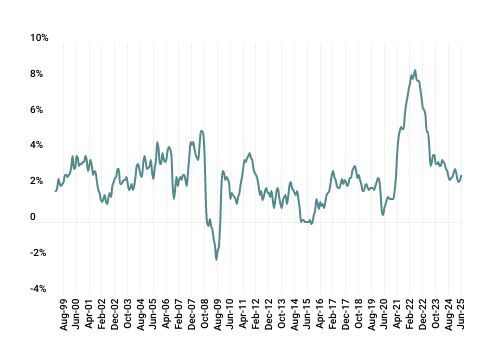
ROLLING 12-MONTH CONSUMER PRICE INDEX
25 YEARS THROUGH JUNE 2025
The Consumer Price Index for All Urban Consumers (CPI-U) increased 0.1% in May after a gain of 0.2% in April; similarly, the all-items index was up 2.4% year-over-year through May, compared to 2.3% through April. Over the past twelve months, the major contributors have been natural gas (+15.3%), shelter (+3.9%), and food (+2.9%).
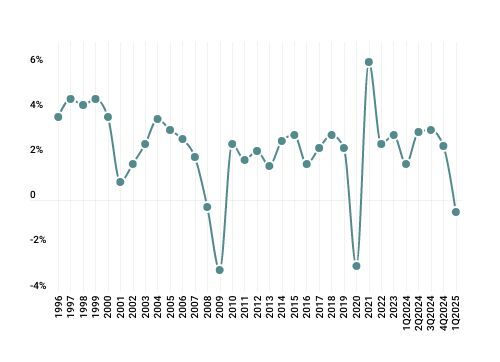
REAL GROSS DOMESTIC PRODUCT
25 YEARS THROUGH Q2 2025
During Q1 2025, real GDP declined by 0.5%, primarily due to a surge in net imports (which are subtracted in Commerce Department GDP calculations) as businesses accelerated purchases ahead of anticipated tariffs, marking the fastest import growth since Q3 2020. By industry, the main detractors were private goods-producing and private services-producing sectors, down 2.8% and 0.3% respectively, while state and local government, information, and real estate were positive contributors.

RETAIL SALES
Total retail and food sales declined by 0.9% in May, marking the second consecutive monthly drop and reversing gains from earlier in the year when consumers pulled forward spending ahead of tariffs. The decline was led by motor vehicle and parts dealers (-3.5% MoM), building materials (-2.7%), and gas stations (-2.0%). Despite the recent weakness, year-over-year sales growth remains positive, though slower, driven by gains in healthcare and personal care, furniture, home furnishings, and non-store retailers.
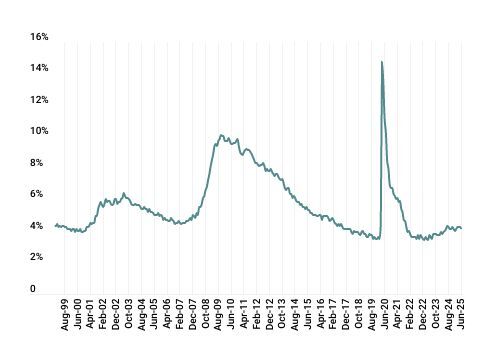
Unemployment RATE
25 YEARS THROUGH June 2025
The US economy added 147,000 jobs in June 2025, just ahead of the trailing twelve-month average of 146,000. Areas of growth included state government (+47,000), healthcare (+39,000), and social assistance (+19,000), while losses continued among the federal government (-7,000). The unemployment rate (4.1%) was down slightly from the prior quarter, as was the labor-force participation rate (62.53%). For the past twelve months, both have been relatively rangebound. Wage growth trends were similarly unchanged, with average hourly earnings for all employees on private non-farm payrolls increasing by 0.2 % in June and 3.7% over the past twelve months.
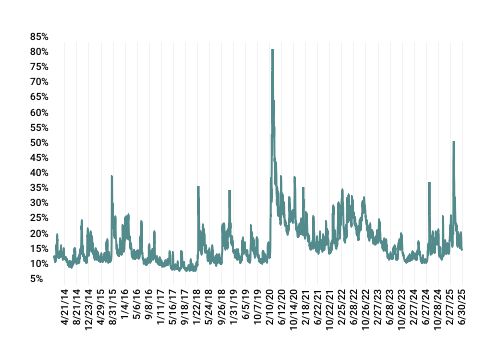
CBOE VIX DAILY CLOSING VALUES
LAST 10 YEARS
Market volatility, as measured by the VIX Index, averaged 23.6 in Q2 2025, but spiked sharply in early April following President Trump’s “Liberation Day” announcement of sweeping tariffs on nearly all countries. This VIX spike was well above the 99th percentile, signaling extreme investor risk aversion, though still below the highs seen in 2008 and 2020; during this period, SPX options volume set a new single-day record with 6.04 million contracts traded. Volatility moderated after the administration announced a four-month pause for tariff implementation, and the VIX ended the quarter at 17.2
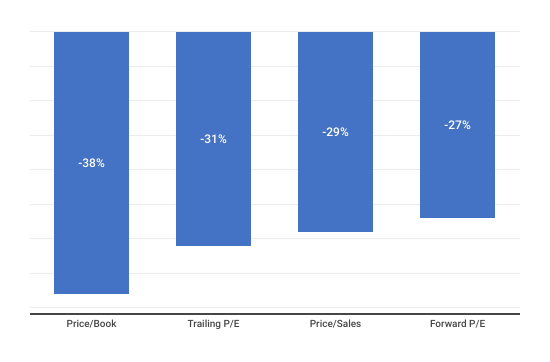
CPI
The Consumer Price Index for All Urban Consumers (CPI-U) increased 0.3% in December, following a 0.1% increase in November. The all-items index rose 3.4% before seasonal adjustment over the previous twelve months. Over the past twelve months, the major contributors include transportation services, up 9.7% (driven by motor-vehicle insurance, up 20.3%), tobacco and smoking products, up 7.8%, and shelter, up 6.2%.

GDP
During Q3 2023, real GDP rose at an annual rate of 4.9% followed by a 2.1% increase in Q2 2023. The increase was driven by consumer spending and inventory investment; imports also increased. Overall, 14 of 22 industry groups contributed to real GDP growth in the third quarter; the value added from private goods-producing industries was particularly strong at 10.2%.

Retail Sales
Total retail and food sales increased 0.3% and 4.1% month-to-date and year-to-date ending November 2023, respectively. Total sales from September through November 2023 were up 3.4% compared to the same period one year ago; the percentage change over the same period was up 0.4%. Significant contributors include non-store retailers and food services and drinking places.

Unemployment

VIX
Market volatility, as measured by the VIX Index, had an average close in Q4 2023 at 15.29, trending up from Q3 (15.01) and down from Q2 (16.48). The index has dropped below its five-year average of 20.58, reflecting positive investor sentiment and a high level of comfort with the overall direction of the economy.
GMS Table Templates
| Q4 2023 | YTD | Q4 2023 |
YTD
|
||
|
Title
|
0%
|
0%
|
Title
|
0%
|
0%
|
|
Title
|
0%
|
0%
|
Title
|
0%
|
0%
|
|
Title
|
0%
|
0%
|
Title
|
0%
|
0%
|
| Q4 2023 | YTD | Q4 2023 |
YTD
|
||
|
Large Cap Value
|
0%
|
0%
|
Large Cap Growth
|
0%
|
0%
|
|
Mid Cap Value
|
0%
|
0%
|
Mid Cap Growth
|
0%
|
0%
|
|
Small Cap Value
|
0%
|
0%
|
Small Cap Growth
|
0%
|
0%
|
| U.S. Large Cap | U.S. Mid Cap | U.S. Small Cap | ||||
| Q4 2023 | YTD | Q4 2023 | YTD | Q4 2023 |
YTD
|
|
|
Title
|
0%
|
0%
|
0%
|
0%
|
0%
|
0%
|
|
Title
|
0%
|
0%
|
0%
|
0%
|
0%
|
0%
|
|
Title
|
0%
|
0%
|
0%
|
0%
|
0%
|
0%
|
|
Title
|
0%
|
0%
|
0%
|
0%
|
0%
|
0%
|
|
Title
|
0%
|
0%
|
0%
|
0%
|
0%
|
0%
|
|
Title
|
0%
|
0%
|
0%
|
0%
|
0%
|
0%
|
|
Title
|
0%
|
0%
|
0%
|
0%
|
0%
|
0%
|
|
Title
|
0%
|
0%
|
0%
|
0%
|
0%
|
0%
|
|
Title
|
0%
|
0%
|
0%
|
0%
|
0%
|
0%
|
|
Title
|
0%
|
0%
|
0%
|
0%
|
0%
|
0%
|
|
Title
|
0%
|
0%
|
0%
|
0%
|
0%
|
0%
|
|
Title
|
0%
|
0%
|
0%
|
0%
|
0%
|
0%
|
|
Title
|
0%
|
0%
|
0%
|
0%
|
0%
|
0%
|
| Header | Header | |||
| Header | Q4 2023 | YTD | Q4 2023 | YTD |
|
Title1
|
0%
|
0%
|
0%
|
0%
|
|
Title2
|
0%
|
0%
|
0%
|
0%
|
|
Title3
|
0%
|
0%
|
0%
|
0%
|
|
Title4
|
0%
|
0%
|
0%
|
0%
|
|
Title5
|
0%
|
0%
|
0%
|
0%
|
| Header | Header | |
| Header | Q4 2023 | Q4 2023 |
|
Title1
|
0%
|
0%
|
|
Title2
|
0%
|
0%
|
|
Title3
|
0%
|
0%
|
|
Title4
|
0%
|
0%
|
|
Title5
|
0%
|
0%
|
| Country | Best Performing Style |
|
Title1
|
Value
|
|
Title2
|
Value
|
|
Title3
|
Value
|
|
Title4
|
Value
|
|
Title5
|
Value
|
|
Title6
|
Value
|
|
Title7
|
Value
|
|
Title8
|
Value
|
|
Title9
|
Value
|
|
Title10
|
Value
|
|
Title11
|
Value
|
|
Title12
|
Value
|
|
Title13
|
Value
|
Returns by style
| Q4 2023 | YTD | Q4 2023 |
YTD
|
||
|
Large Cap Value
|
0%
|
0%
|
Large Cap Value
|
0%
|
0%
|
|
Mid Cap Value
|
0%
|
0%
|
Mid Cap Value
|
0%
|
0%
|
|
Small Cap Value
|
0%
|
0%
|
Small Cap Value
|
0%
|
0%
|
| Q4 2023 | YTD | Q4 2023 |
YTD
|
||
|
Large Cap Value
|
0%
|
0%
|
Large Cap Growth
|
0%
|
0%
|
|
Mid Cap Value
|
0%
|
0%
|
Mid Cap Growth
|
0%
|
0%
|
|
Small Cap Value
|
0%
|
0%
|
Small Cap Growth
|
0%
|
0%
|
SECTOR Returns BY CAPITALIZATION
| U.S. Large Cap | U.S. Mid Cap | U.S. Small Cap | ||||
| Q4 2023 | YTD | Q4 2023 | YTD | Q4 2023 |
YTD
|
|
|
Basic Materials
|
0%
|
0%
|
0%
|
0%
|
0%
|
0%
|
|
Consumer Goods
|
0%
|
0%
|
0%
|
0%
|
0%
|
0%
|
|
Consumer Services
|
0%
|
0%
|
0%
|
0%
|
0%
|
0%
|
|
Financials
|
0%
|
0%
|
0%
|
0%
|
0%
|
0%
|
|
Health Care
|
0%
|
0%
|
0%
|
0%
|
0%
|
0%
|
|
Industrials
|
0%
|
0%
|
0%
|
0%
|
0%
|
0%
|
|
Oil & Gas
|
0%
|
0%
|
0%
|
0%
|
0%
|
0%
|
|
Real Estate
|
0%
|
0%
|
0%
|
0%
|
0%
|
0%
|
|
Technology
|
0%
|
0%
|
0%
|
0%
|
0%
|
0%
|
|
Telecommunications
|
0%
|
0%
|
0%
|
0%
|
0%
|
0%
|
|
Utilities
|
0%
|
0%
|
0%
|
0%
|
0%
|
0%
|
|
Source: Russell Investments & Industry Classification Benchmark
|
||||||
|
Large Cap: Russell Top 200 Index | Mid Cap: Russell Mid Cap Index | Small Cap: Russell 2000 Index
|
||||||
us valuations
| Quarter Ending 12/31/2023 | Quarter Ending 9/30/2023 | |||
| US Large Cap Equity | Value | Growth | Value | Growth |
|
Price/Earnings Ratio
|
0%
|
0%
|
0%
|
0%
|
|
IBES LT Growth (%)
|
0%
|
0%
|
0%
|
0%
|
|
1 Year Forward P/E Ratio
|
0%
|
0%
|
0%
|
0%
|
|
Negative Earnings (%)
|
0%
|
0%
|
0%
|
0%
|
| Quarter Ending 12/31/2023 | Quarter Ending 9/30/2023 | |||
| US Mid Cap Equity | Value | Growth | Value | Growth |
|
Price/Earnings Ratio
|
0%
|
0%
|
0%
|
0%
|
|
IBES LT Growth (%)
|
0%
|
0%
|
0%
|
0%
|
|
1 Year Forward P/E Ratio
|
0%
|
0%
|
0%
|
0%
|
|
Negative Earnings (%)
|
0%
|
0%
|
0%
|
0%
|
| Quarter Ending 12/31/2023 | Quarter Ending 9/30/2023 | |||
| US Small Cap Equity | Value | Growth | Value | Growth |
|
Price/Earnings Ratio
|
0%
|
0%
|
0%
|
0%
|
|
IBES LT Growth (%)
|
0%
|
0%
|
0%
|
0%
|
|
1 Year Forward P/E Ratio
|
0%
|
0%
|
0%
|
0%
|
|
Negative Earnings (%)
|
0%
|
0%
|
0%
|
0%
|
international valuations
| Quarter Ending 12/31/2023 | Quarter Ending 9/30/2023 | |||
| International Equity | Value | Growth | Value | Growth |
|
Price/Earnings Ratio
|
0%
|
0%
|
0%
|
0%
|
|
IBES LT Growth (%)
|
0%
|
0%
|
0%
|
0%
|
|
1 Year Forward P/E Ratio
|
0%
|
0%
|
0%
|
0%
|
|
Negative Earnings (%)
|
0%
|
0%
|
0%
|
0%
|
| Quarter Ending 12/31/2023 | Quarter Ending 9/30/2023 | |||
| Emerging Markets Equity | Value | Growth | Value | Growth |
|
Price/Earnings Ratio
|
0%
|
0%
|
0%
|
0%
|
|
IBES LT Growth (%)
|
0%
|
0%
|
0%
|
0%
|
|
1 Year Forward P/E Ratio
|
0%
|
0%
|
0%
|
0%
|
|
Negative Earnings (%)
|
0%
|
0%
|
0%
|
0%
|
|
Source: Russell Investments Total Equity Profile
|
||||
non-us developed / emerging cap & style
| Q4 2023 | YTD | Q4 2023 |
YTD
|
||
|
Large Cap Value
|
0%
|
0%
|
Large Cap Value
|
0%
|
0%
|
|
Mid Cap Value
|
0%
|
0%
|
Mid Cap Value
|
0%
|
0%
|
|
Small Cap Value
|
0%
|
0%
|
Small Cap Value
|
0%
|
0%
|
| Header | Header | |
| Header | Q4 2023 | Q4 2023 |
|
Title1
|
0%
|
0%
|
|
Title2
|
0%
|
0%
|
|
Title3
|
0%
|
0%
|
|
Title4
|
0%
|
0%
|
|
Title5
|
0%
|
0%
|
| Country | Best Performing Style |
|
Australia
|
Value
|
|
Brazil
|
Value
|
|
Canada
|
Value
|
|
China
|
Value
|
|
France
|
Value
|
|
Germany
|
Value
|
|
Hong Kong
|
Value
|
|
Indonesia
|
Value
|
|
Italy
|
Value
|
|
Japan
|
Value
|
|
Mexico
|
Value
|
|
Singapore
|
Value
|
|
Spain
|
Value
|
|
Thailand
|
Value
|
GLOBAL EQUITY PERFORMANCE
Global equities posted strong gains in Q2 2025, rebounding from early quarter volatility tied to President Trump’s tariff announcements and their subsequent pause. The S&P 500 rose 10.9%, MSCI EAFE 11.8%, and emerging markets 12.0%, as resilient corporate earnings and optimism around AI and trade talks improved sentiment. The MSCI ACWI ex-US also gained 12.0%, led by Portugal (+23.8%), Austria (+21.9%), and the Netherlands (+18.25%). Portuguese markets benefited from heavy cyclical and energy exposure amid a new government-led infrastructure push, while Austria and the Netherlands saw gains from improving macro conditions and increased German spending on defense, infrastructure, and climate policy. South Korea was the top-performing market overall, rising 32.7%, as investor confidence surged following the election of President Lee Jae-myung, whose administration announced reforms aimed at improving corporate governance, tax policy, and addressing the long-standing “Korean Discount.”
row-spacer
row-spacer
US VALUATIONS
US equities are expected to report 4.8% year-over-year earnings growth for Q2 2025, with gains led by communication services (+30%) and information technology (+17%), while energy (-26%) and consumer discretionary (-5%) are projected to decline. Looking ahead, analysts forecast 9% earnings growth and 5% revenue growth for calendar-year 2025. Valuations rose across all size and style segments during the quarter, with the strongest multiple expansion among growth equities. On a normalized basis, the S&P 500 remains expensive, trading at a cyclically adjusted P/E (CAPE) more than two standard deviations above its historical average.
INTERNATIONAL VALUATIONS
Non-US developed equities saw modest multiple expansion across both growth and value styles in Q2, yet continue to trade at a discount to US equities and historical averages. Emerging-market valuations remained largely unchanged and similarly inexpensive in both absolute and relative terms. Looking ahead through 2025, earnings are projected to grow 13% for Europe, 3% for Japan, and 12% for emerging markets.
US SPREAD PRODUCTS
Investment-Grade Corporate Bonds: The market returned 2.3% for the quarter; coupons and spread compression drove gains while the steepening Treasury yield curve had mixed effects. Spreads narrowed by 11 bps (to 83 bps), near historical lows and 33 bps below the ten-year median, but this masks elevated volatility in April (spreads widened to as much as +120 bps). Lower-quality issues outperformed: Baa-rated corporates, 2.0%; A-rated, 1.8%; and Aa-rated, 1.0%. Quarterly issuance increased 10% year over year to $400 billion.
High-Yield Corporate Bonds: The market returned 3.5% for the quarter; coupons and spread compression drove gains while the steepening Treasury yield curve had mixed effects. Spreads narrowed by 57 bps (to 290 bps), near historical lows and 86 bps below the ten-year median, but this masks elevated volatility in April (spreads widened to as much as +450 bps). Lower-quality bonds led performance: Caa-rated corporates, 4.0%; B-rated, 3.6%; and Ba-rated, 3.4%. Quarterly issuance decreased 10% year over year to $70 billion.

hello world

GDP
During Q3 2023, real GDP rose at an annual rate of 4.9% followed by a 2.1% increase in Q2 2023. The increase was driven by consumer spending and inventory investment; imports also increased. Overall, 14 of 22 industry groups contributed to real GDP growth in the third quarter; the value added from private goods-producing industries was particularly strong at 10.2%.

Retail Sales
Total retail and food sales increased 0.3% and 4.1% month-to-date and year-to-date ending November 2023, respectively. Total sales from September through November 2023 were up 3.4% compared to the same period one year ago; the percentage change over the same period was up 0.4%. Significant contributors include non-store retailers and food services and drinking places.

Unemployment
A total of 494,000 jobs were created in the fourth quarter of 2023, which did not outpace the previous quarter’s gains of 710,000. The US economy added 216,000 jobs in November, which is below the twelve-month average monthly gain of 225,000. December’s notable job gains occurred within the following industries: government (+52,000), health care (+38,000), social assistance (+21,000), and construction (+17,000).
The unemployment rate remains unchanged from the previous quarter’s average at 3.7%. The number of unemployed persons (6.3 million) experienced minimal net movement as well. The labor force participation rate decreased by 0.3% in December (62.5%).

VIX
During Q2 2023, real GDP rose at an annual rate of 2.1%, following a 2.2% increase in Q1. The increase was driven by state and local government spending, non-residential fixed investment, and consumer spending, partially offset by a decrease in exports; imports also decreased. Relative to Q1, the second quarter experienced a slowdown in consumer and federal government spending alongside the decline in exports, which drove the Q2 deceleration of real GDP.
Charts
YIELD CURVE
The US Treasury yield curve steepened moderately to end a volatile quarter. Two- and five-year note yields each fell by 17 bps; ten-year note and 30-year bond yields rose by 1 and 19 bps, respectively. The two- to ten-year spread widened by 18 bps (to 52 bps), the highest level since mid-2022 but still below the historical 85 bps average. Intra-quarter Treasury volatility was elevated: in the case of the ten-year note, yields ranged from 4.0% to 4.6%, but ended the quarter little changed at 4.2%. Despite volatile conditions, the yield curve has remained relatively flat within a 3.5-5.0% range for most of the last three years; however, beginning in late-2024 and during the first half of 2025, the curve has moved from inversion to a moderately positive slope.


Love these and want more?
Enter your email address below and we will let you know when we add new resources.
